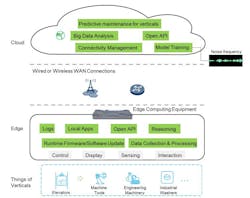With more than 40 percent of respondents to a recent Automation World survey noting they already use edge computing to some degree, it’s clear that the technology is beginning to be applied widely across industry. At the same time, the survey results indicate that more than half of the industrial audience has not yet begun to implement edge computing.
Considering that we’re still very much in the early days of edge computing, the Industrial Internet Consortium’s (IIC) recent release of its “IIC Introduction to Edge Computing in IIoT” white paper is well timed. According to the IIC, the paper provides practical guidance on edge computing, architectures and the building blocks necessary for edge computing implementations.
Topics addressed in the paper include: where the edge device should reside in different application scenarios; the defining characteristics of edge computing; key drivers for implementation; as well as the reasons for deploying compute capabilities at the edge in Industrial Internet of Things (IIoT) systems.
“The white paper is a first step in the development of an industrial grade ‘cookbook’ for edge computing,” said Dr. Mitch Tseng, distinguished consultant, Huawei Technologies, and co-author of the paper.
In addition to providing basic information about edge computing to an industrial audience, the paper is also designed to guide the IIC’s architecture and testbed teams focused on edge technologies by identifying and evaluating standards, practices and characteristics best suited for edge computing. The paper will also be used by IIC teams to identify deployment models and crosscutting functions that address patterns and characteristics for edge computing deployment, and to explore and identify extensions to the current edge computing model that expand and enhance the functionality of edge computing devices.
Several real-world application examples are highlighted in the paper to help readers better grasp the relevance and practicality of edge computing. These examples include:
Equipment Protection. Here, the white paper describes the advantages of edge computing coupled with the use of a “dumb” thermocouple to measure temperature on a pump. According to the paper, “a pump with edge computing capability can perform basic analytics to determine if a defined threshold has been exceeded and shut the pump down in milliseconds.” Using an edge computing device for such an application means that there is no decision latency and no requirement for Internet connectivity to perform this function. In this example, with edge computing installed at the device level, the paper notes that the key objective of the implementation can be consistently achieved, even if connectivity to higher-level systems and networks is interrupted.
Performance Monitoring. In this example, the paper describes the use of edge computing at the plant level, rather than on a specific device. Specifically, edge computing performs “near real-time analytics on multiple data points from sensors in the plant so the data can be processed on a local gateway to provide overall equipment effectiveness (OEE) trends and alerts to operational systems or personnel. Though such multi-source analytics could be performed in the cloud, the paper suggests that the time value of information [n these types of applications is high and response delays waiting for decisions from the cloud can cause significant losses.
Supply Chain Optimization. According to the paper, supply chain edge computing scenarios obtain data from multiple sources at short intervals to apply optimization algorithms and analytics that can adapt plans in supply chain management (SCM) or enterprise resource planning (ERP) business systems. As such, edge analytics are performed at the perimeter of the plant and will require local or factory-level connectivity. Analyses done here will not be completed in seconds or minutes, as is the case with most on-machine edge computing applications. Because of the multi-system connections, these analyses will require processing times of hours rather than seconds or minutes.
Another example highlighted in the paper references analytics performed at the enterprise level using a public or private cloud. The paper claims that such use of cloud computing is “at the top end of the edge continuum” and that what defines the edge is not so much where the computational analysis is done, but rather where data is used to achieve a specific key objective or to address a specific business problem.
Based on edge computing interviews I’ve conducted over the past few years, such a view would indicate a much broader perspective of edge computing than most industry experts adhere to currently. But as edge and cloud computing technologies and applications increasingly intertwine, this perspective may not remain outside the mainstream for long.
In the coming months, the IIC will release an “Edge Computing Technical Report,” which it says will serve as a companion piece to the white paper and that will contain more in-depth technical information.

